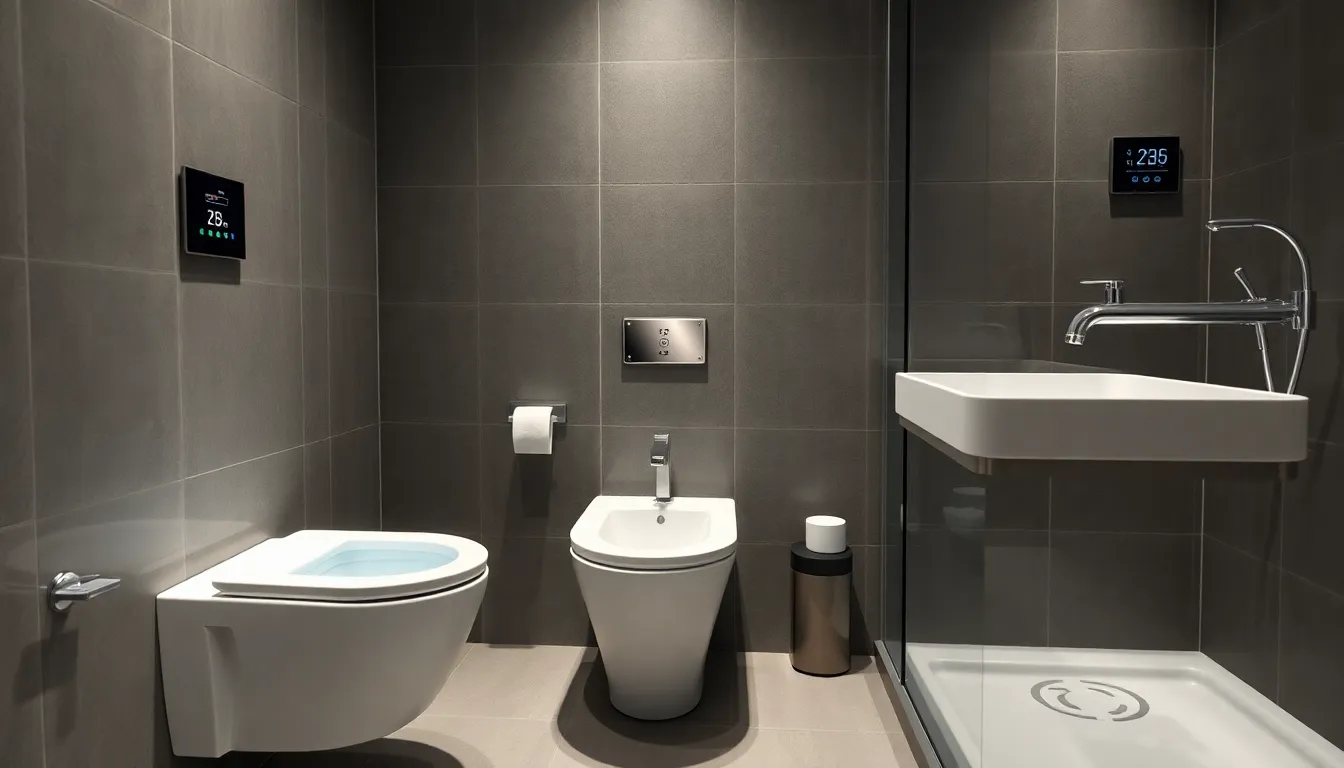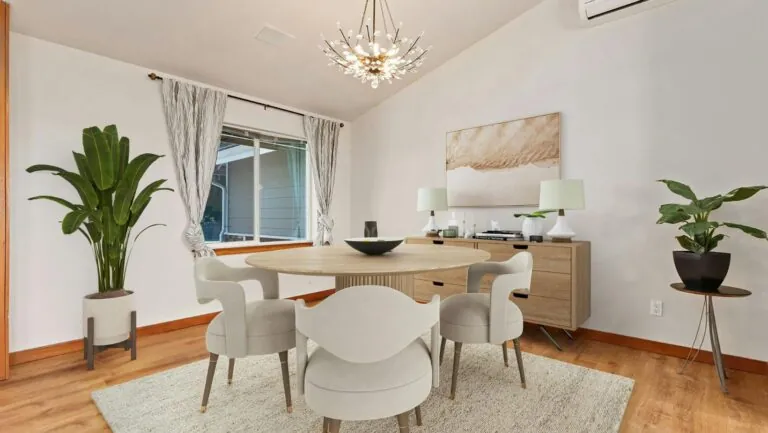In today’s fast-paced world, smart bathroom technology is transforming the way people experience their daily routines. From automated faucets to intelligent mirrors, these innovations not only enhance convenience but also promote sustainability and efficiency. As homeowners seek to create personal sanctuaries, integrating smart devices into the bathroom has become a popular trend.
Imagine stepping into a bathroom that adjusts the lighting and temperature to your preference while playing your favorite music. This technology isn’t just about luxury; it’s about improving overall well-being and streamlining everyday tasks. As advancements continue to emerge, the smart bathroom is evolving into a hub of comfort and connectivity, making it an essential aspect of modern living.
Table of Contents
ToggleOverview of Smart Bathroom Technology
Smart bathroom technology encompasses various innovative devices designed to enhance both functionality and comfort. Devices such as automated faucets, intelligent mirrors, and smart toilets provide users with unprecedented convenience. These technologies allow for remote operation and customization, enabling bathrooms to adapt to individual needs.
Key Features of Smart Bathroom Technology
- Automated Faucets: Faucets equipped with sensor technology offer hands-free operation, helping to conserve water and promote hygiene.
- Smart Mirrors: Mirrors with integrated displays can provide real-time information such as weather updates or personal calendar reminders while enabling voice control.
- Smart Toilets: Toilets with features like heated seats, bidet functionality, and self-cleaning systems enhance comfort and cleanliness.
- Temperature Control: Smart showers and bathtubs can be programmed to reach desired temperatures, minimizing water usage and ensuring a pleasant experience.
- Lighting Systems: Smart lighting can adjust automatically based on time of day or user preferences, promoting relaxation or energizing environments.
Benefits of Smart Bathroom Technology
- Convenience: Automating routine tasks like turning on water or adjusting lighting provides instant ease.
- Efficiency: Reduced water and energy consumption contribute to sustainability goals.
- Customization: Users can personalize their bathroom experience, creating a space tailored to individual preferences.
- Improved Health: Features like touchless controls and automated cleaning options foster a more hygienic environment.
Smart bathroom technology represents a fusion of luxury and practicality, transforming standard bathrooms into personalized, high-tech spaces that cater to modern lifestyles.
Key Components of Smart Bathrooms

Smart bathrooms incorporate various technologies that enhance functionality and user experience. Key components include smart toilets, intelligent showers, and automated faucets, each offering unique benefits and features.
Smart Toilets
Smart toilets offer advanced features like bidet functions, heated seats, and self-cleaning capabilities. They enhance hygiene and comfort while reducing toilet paper use. Some models include integrated sensors that self-open the lid, flush automatically, and adjust water temperature for a customized experience. Users can control settings through smartphone apps for added convenience and personalization.
Intelligent Showers
Intelligent showers provide a tailored bathing experience with programmable settings. Users can preset water temperature, flow rate, and duration, ensuring an optimal shower every time. Many systems incorporate digital displays that provide real-time data on water usage, promoting efficiency and conservation. Some models use voice control, allowing users to start showers hands-free, enhancing accessibility and ease of use.
Automated Faucets
Automated faucets enhance water conservation and sanitation through touchless operation. Equipped with motion sensors, these faucets activate water flow only when hands are present, reducing waste. They can also feature adjustable water temperature and flow settings, allowing for a customized experience. These faucets improve hygiene by minimizing contact with surfaces, making them ideal for households prioritizing cleanliness.
Benefits of Smart Bathroom Technology
Smart bathroom technology significantly improves daily living by merging comfort with functionality. The advantages include enhanced convenience, water conservation, and improved hygiene.
Enhanced Convenience
Smart bathroom technology offers seamless operation through voice activation and automation. Touchless faucets turn on automatically, allowing users to wash hands without physical contact. Intelligent mirrors display real-time information like weather updates and calendar events, streamlining morning routines. Programmable shower systems let users preset water temperature and flow, ensuring a personalized experience with minimal effort.
Water Conservation
Smart bathroom devices contribute to sustainable practices through efficient resource management. Automated faucets automatically shut off after use, reducing unnecessary water waste. Smart toilets often include dual-flush systems, providing options for liquid and solid waste, thus minimizing overall water usage. Intelligent shower systems monitor and adjust water flow to conserve resources without sacrificing comfort.
Improved Hygiene
Smart bathroom technology enhances sanitation through innovative features. Touchless faucets and soap dispensers reduce surface contact, lowering the risk of germ transmission. Self-cleaning toilets utilize advanced technology to maintain hygiene effortlessly. Smart mirrors may include anti-fog functions, enabling clear visibility while promoting a cleaner, healthier environment in the bathroom.
Challenges and Considerations
Smart bathroom technology presents challenges that warrant careful consideration. While these innovations offer numerous advantages, understanding their implications is crucial for potential users.
Cost Implications
Smart bathroom devices often come with a higher upfront cost compared to traditional fixtures. Prices for smart toilets can range from $500 to over $5,000, depending on features and brand. Smart mirrors and automated faucets typically range from $200 to $1,500. In addition to purchase costs, maintenance and potential repairs for advanced technology may incur further expenses. Budgeting for these financial considerations ensures a well-rounded assessment before investing in smart bathroom solutions.
Installation Requirements
Installation of smart bathroom technology can involve various complexities. Many intelligent devices require existing plumbing or electrical systems to accommodate their features. Some smart toilets may need modifications to a bathroom’s plumbing layout. Automated faucets and smart mirrors often necessitate electrical outlets, while intelligent showers might require dedicated wiring. Professional installation may be advisable for optimal functionality and safety, which adds to the overall cost. Evaluating these requirements helps in planning and executing a successful smart bathroom upgrade.
Future Trends in Smart Bathroom Technology
Smart bathroom technology continues to evolve, driven by advancements in Internet of Things (IoT) integration, artificial intelligence (AI), and sustainability efforts. Upcoming trends indicate greater customization and efficiency for users.
- Integration with Home Automation Systems: Smart bathrooms will increasingly connect with broader home automation systems. Devices will communicate seamlessly, allowing for synchronized routines, such as lighting adjustments, music playback, and temperature control upon entering the bathroom.
- Voice-Activated Features: As voice recognition technology matures, more smart bathroom devices will incorporate this feature. Voice-controlled faucets and toilets will enhance convenience, enabling users to access functions hands-free.
- Health Monitoring Capabilities: Future smart bathrooms may include health monitoring features. Intelligent mirrors could analyze skin conditions or vital signs, providing personalized health insights and recommendations.
- Sustainable Practices: Innovations will focus on energy and water conservation. Smart water sensors will detect leaks, ensuring rapid responses to maintenance needs. Technology will continue to promote eco-friendly practices, such as low-flow toilets and smart showers that optimize water usage.
- Personalized Experiences: Customization will remain a significant trend. Users will benefit from devices that adapt to individual preferences, such as programmable water temperature and pressure settings in showers. Smart mirrors may also offer tailored advice based on user input.
- Enhanced Safety Features: Smart bathroom technology will incorporate safety measures. Motion sensors can log movement patterns, alerting users to unusual activity, which can be especially beneficial for elderly individuals.
- Simplicity in Maintenance: Manufacturers will prioritize easy maintenance in future designs. Smart toilets with self-cleaning mechanisms and intuitive diagnostic features will minimize upkeep, ensuring optimal performance.
Through these advancements, smart bathroom technology aims to enhance user experience, improve health outcomes, and promote sustainable living. The commitment to innovation signals a transformative future for personal care spaces.
Smart bathroom technology is reshaping how individuals experience their personal spaces. With innovations like automated faucets and intelligent mirrors, these advancements not only enhance convenience but also promote sustainability and hygiene. As homeowners embrace these technologies, they’re creating tailored environments that cater to their unique preferences.
The future of smart bathrooms looks promising, with ongoing developments in IoT and AI driving further customization and efficiency. While the initial investment and installation may pose challenges, the long-term benefits of comfort, resource conservation, and improved well-being make smart bathroom technology a worthwhile consideration. Embracing this trend means stepping into a new era of home living where luxury meets practicality.




